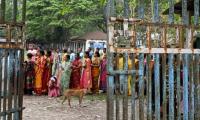It does not happen very often that you read an academic article on happenings in the world in the broader sense, and feel that it is equally applicable to developments in Pakistan.
There has been ‘democratic backsliding’ in all regions of the world, particularly from 2006 onwards. It is worthwhile to discuss the worldwide receding democracy and this article refers to some literature (Freedom House’s ‘Freedom in the World 2018’; Diamond 2002; Huq and Ginsburg 2018) to illustrate the discussion.
The above-cited Freedom House report appears to be based on data till 2017. Democracy is facing ‘serious crisis’ in terms of being challenged to hold free and fair elections, protect the rights of minorities, ensure press freedom, and work within the parameters of rule of law. According to this report, 113 countries in the world have gone through shrinking of the net democratic freedoms, and only 62 countries have shown an overall improvement since 2006 in an era that has seen overall global decline.
The year 2017 is marked as the 12th consecutive year of global freedoms experiencing net decline in civil liberties and political rights. This quashes the tall claims of a post-cold war era of a quarter century ago about the triumph of the ‘end of history’ with the liberal democratic order having won. It appears far from it.
‘Freedom in the World 2018’ states that in terms of cross-country comparison, only 45 percent countries are free (in the broader democratic sense that includes enjoying political rights and civil liberties as well), 30 percent of countries are partly free, and 25 percent of countries are not free in the world. If we apply the same lens to global population (instead of countries), 39 percent of the world’s population is free, 24 percent is only partly free, and 37 percent is not free.
It is obvious from these statistics that the majority of countries in the world or the global population is either only partly free or not free. It includes declines of freedom in the developed world (as well as all regions of world counting developing countries in); the declining norms of democracy in the US have been particularly highlighted in more than one pieces of literature.
In the Freedom House methodology, freedom for all countries in the world measures on a scale of 1 to 7 with 1 being ‘most free’ and 7 being ‘least free’; Pakistan has been termed as ‘partly free’ according to the above-mentioned index. Pakistan’s score on political rights freedom is 4/7 and civil liberties 5/7, with an overall rating of 4.5/7. Pakistan’s aggregate score is 43 on a scale of 0 to 100 with 0 being the ‘least free’ and 100 being the ‘most free’.
The point is not to buy such ratings uncritically. There is more than one source that produces such ratings: ‘The Economist’s’ Intelligence Unit does it own and so does some other literature; and we would discuss some of these in the future. Most of these ratings are based on perception surveys, and analysis of the secondary literature, and use diverse methodologies to measure the strengths and weakness of democracy.
In cross-country comparisons, there is risk of comparing apples with oranges. Yet, it is worthwhile to bring them into discussion as such ratings are approximate indications of structural changes in the way democracy is practised and challenged in countries, regions, and by aggregation in the world.
In political science literature, there is criticism of considering democracy synonymous to holding multiparty elections only. Ensuring political and civil liberties, enforcement of rule of law backed by an independent judiciary, free and diverse media, freedom of association, availability of information, institution of a system of checks and balances, formulation of government policies on the basis of citizens’ preferences guided by the vote are equally important (amongst other criteria) to judge a democracy, as per The Economist’s Intelligence Unit and some other sources.
However, there are many countries in the world that have only the ‘form’ of electoral democracy but not its ‘substance’. Democracy evolved gradually even in the developed world. First, only a small male (often propertied) elite had the right to franchise and then it gradually diffused to larger population, including women.
In the contemporary world of adult suffrage, there is no more a gradualist approach to democracy; hence the elite find other ways to control and limit political competition (political competition means that when the entry barriers to join politics are low and entry is open to wider public, and the citizens have the right to choose amongst the diverse political players and parties). Hence, we are seeing indirect curbs on democracy that limit it to the electoral ‘form’ only.
There are one party hegemonic political setups, ‘competitive authoritarian’ systems, forms of ‘illiberal democracy’ or ‘semi-democracy’, and some variant of ‘hybrid regimes’ in the world. A hybrid regime refers to ‘political grey zone’ that exists in-between a full-fledged substantive democracy and dictatorship.
Democracy is in ‘recession’ or, for some other analysts, appears to be in complete ‘retreat’. The increase in economic inequalities, particularly in the post-2008 world financial crisis, is linked to the rise of authoritarianism and reversal of democracy.
Huq and Ginsburg (2018) have captured the actual and potential decline in democracy by differentiating between ‘authoritarian reversion’ and ‘constitutional retrogression’. The former is a quick and complete collapse of a country onto the authoritarian path such as in a coup or by declaring a state of emergency. However, it is becoming rare in the world.
The more common form of reversal seems to be gradual democratic backsliding in terms of ‘constitutional retrogression’ in a more subtle way. In other words “a more incremental (but ultimately substantial) decay in three basic predicates of democracy – competitive elections, liberal rights to speech and association, and the adjudicative and administrative rule of law necessary for democratic choice to thrive”.
In other words, the ‘toolkit’ used by those pushing for reversal of democracy has become more subtle and sophisticated. It includes populism, portrayal of the majority as underdogs, appeal on the basis of threats to national security and narrow nationalism. Constitutional backsliding has happened in Hungary, Turkey, the US, UK, Venezuela, Thailand, Sri Lanka, India, Poland to name a few in contemporary times.
In the broader sense, developments in Pakistan need to be viewed in the context of global undercurrents of democratic backsliding.
The writer is an Islamabad-based social scientist.
A woman walks past a building of the International Monetary Fund. — AFP/FileThe annual and spring meetings of the...
Late Benazir Bhutto's daughter Asifa Bhutto Zardari addresses the Christian community in Bihar Colony on January 23,...
Representational image. — PexelsWater is an important scarce natural resource that is required for several everyday...
Pakistani employees of online marketplace company Kaymu at work in Karachi. — AFP/FileThe true spirit of development...
India uses Afghanistan as a backstage area to carry out terrorist attacks against Pakistan
Another report by the Pakistan Institute of Peace Studies states that 78 per cent of attacks have been carried out by...







